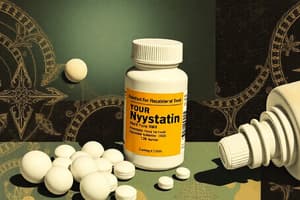Podcast
Questions and Answers
What is specifically inhibited by Echinocandin and Pneumocandin in fungi?
What is specifically inhibited by Echinocandin and Pneumocandin in fungi?
- Chitin synthesis
- Beta-glucan synthase (correct)
- Nucleic acid replication
- Ergosterol biosynthesis
What is the target of Echinocandin and Pneumocandin in fungal cells?
What is the target of Echinocandin and Pneumocandin in fungal cells?
- Mitochondrial ATP production
- Cytoplasmic ribosomes
- Nuclear membrane
- Cell wall synthesis (correct)
Which enzyme's inhibition is targeted by Squalene Epoxidase Inhibitors?
Which enzyme's inhibition is targeted by Squalene Epoxidase Inhibitors?
- Squalene isomerase
- Δ14- reductase
- Squalene epoxidase (correct)
- 14α- demethylase
What is the primary effect of Allylamines and Related Compounds on fungi?
What is the primary effect of Allylamines and Related Compounds on fungi?
What is the impact of Squalene Epoxidase Inhibitors on fungal ergosterol levels?
What is the impact of Squalene Epoxidase Inhibitors on fungal ergosterol levels?
What is the narrow spectrum of activity of Allylamines and Related Compounds primarily limited to?
What is the narrow spectrum of activity of Allylamines and Related Compounds primarily limited to?
How do polyenes like Amphotericin B and Nystatin act on fungal cells?
How do polyenes like Amphotericin B and Nystatin act on fungal cells?
Which polyene antifungal has been reported to cause nephrotoxicity?
Which polyene antifungal has been reported to cause nephrotoxicity?
What toxic effect does Amphotericin B have on host immune cells?
What toxic effect does Amphotericin B have on host immune cells?
What leads to cell death in fungal cells upon binding of polyene antifungals like Amphotericin B?
What leads to cell death in fungal cells upon binding of polyene antifungals like Amphotericin B?
How does Amphotericin B interact with cell membranes to form transmembrane channels?
How does Amphotericin B interact with cell membranes to form transmembrane channels?
Which statement is true about the binding preference of polyenes to cell membranes?
Which statement is true about the binding preference of polyenes to cell membranes?
Why are amphotericin B and Nystatin considered polyenes?
Why are amphotericin B and Nystatin considered polyenes?
What is a key toxic effect associated with the use of polyenes like amphotericin B and Nystatin?
What is a key toxic effect associated with the use of polyenes like amphotericin B and Nystatin?
How do polyenes like Nystatin and amphotericin B exert their antifungal effects?
How do polyenes like Nystatin and amphotericin B exert their antifungal effects?
Which of the following describes the mechanism of action of polyenes like Nystatin and amphotericin B?
Which of the following describes the mechanism of action of polyenes like Nystatin and amphotericin B?
What is a common characteristic of the toxicities seen with polyenes such as Nystatin and amphotericin B?
What is a common characteristic of the toxicities seen with polyenes such as Nystatin and amphotericin B?
Why is it essential to monitor renal function in patients being treated with polyenes like Nystatin and amphotericin B?
Why is it essential to monitor renal function in patients being treated with polyenes like Nystatin and amphotericin B?
Study Notes
Echinocandin and Pneumocandin
- Echinocandin and Pneumocandin specifically inhibit the synthesis of beta-1,3-glucan in fungal cell walls.
- Their main target in fungal cells is the enzyme 1,3-beta-D-glucan synthase, crucial for cell wall integrity.
Squalene Epoxidase Inhibitors
- Squalene Epoxidase Inhibitors target the enzyme squalene epoxidase, which is involved in ergosterol biosynthesis in fungi.
- These inhibitors result in reduced levels of ergosterol, causing disruption in fungal cell membrane integrity.
Allylamines and Related Compounds
- Allylamines and related compounds primarily affect fungi by inhibiting the enzyme squalene epoxidase, which is essential for sterol synthesis.
- Their spectrum of activity is predominantly narrow, primarily targeting dermatophytes and certain yeasts.
Polyenes Antifungal Activity
- Polyenes, such as Amphotericin B and Nystatin, act on fungal cells by binding to ergosterol in the cell membrane, leading to the formation of pores.
- This pore formation causes increased cell permeability and ultimately results in cell death due to leakage of essential cellular components.
Nephrotoxicity and Immune Effects
- Amphotericin B is known to cause nephrotoxicity, which can lead to renal impairment in patients.
- It also has a toxic effect on host immune cells, potentially leading to an inflammatory response that further complicates treatment.
Mechanism of Action for Polyenes
- Upon binding to cell membranes, polyenes like Amphotericin B form transmembrane channels that disrupt homeostasis.
- Polyenes exhibit a higher binding preference for fungal membranes compared to mammalian membranes, which mitigates some toxicity.
Toxicity and Monitoring
- Key toxic effects associated with polyenes include renal toxicity and electrolyte imbalances.
- It is crucial to monitor renal function in patients on polyene therapy due to the risk of nephrotoxicity associated with these antifungals.
Common Characteristics of Polyene Toxicities
- Toxicities observed with polyenes such as Nystatin and Amphotericin B often include nausea, fever, chills, and renal impairment across patients.
Studying That Suits You
Use AI to generate personalized quizzes and flashcards to suit your learning preferences.
Description
Test your knowledge on the mechanism of action of polyene antifungal drugs such as Natamycin, Amphotericin B, and Nystatin. Learn how these drugs bind to ergosterol in fungal cell membranes, leading to pore formation and cell death. Prepared based on Dr. Ghaith Mansour's lecture at Al-Balqa Applied University.




